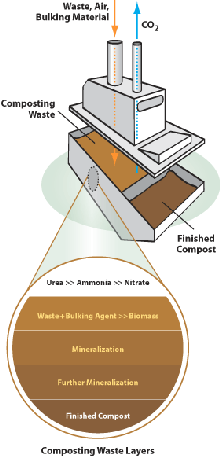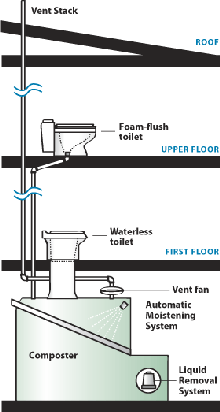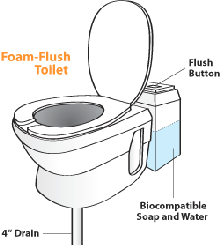1006 Morton Street
Baltimore, MD 21201
410.576.9131 | RW1haWw=
December 3 2007
Clivus Multrum Composting Toilets
Recently, I had the good fortune to take a tour of the sustainable design holy site that is the Philip Joseph Merrill Center in Annapolis MD. It is a great example of the successful implementation of sustainable design and besides it is on a strikingly beautiful piece of land on the edge of the Chesapeake Bay. The building is well worth a visit for designers and lay-people alike even if the earthy aesthetic isn't your style... the technologies used are beautiful in their own right.
One technology was especially touted during the tour... the Clivus Multrum Composting Toilet system. I learned after the tour that composting toilet technology is not new at all, in fact the Clivus Multrum system was developed in 1939 by a Swedish engineer named Rikard Lindstrom. Successive generations of the product led to a patented process in 1962 and an eventual company that designed and produced the product. Clivus Multrum is actually a Swedish word that translates into "sloping chamber" and the product still bears the original concept name today.
The distinct "sloping chamber" remains a design feature of Clivus composters. Together with the custom-designed Clivus Greywater system, these technologies represent a complete on-site system for capturing and recycling nutrients, rather than allowing them to create pollution.
 Composting is the breakdown of organic matter in the presence of aerobic organisms. This is the same process that happens wherever organic matter is exposed to oxygen and moisture: in forests; garden compost piles; lawns; etc. The composting toilet system allows human waste to break down into simple, stable compounds that have value as plant nutrients.
Composting is the breakdown of organic matter in the presence of aerobic organisms. This is the same process that happens wherever organic matter is exposed to oxygen and moisture: in forests; garden compost piles; lawns; etc. The composting toilet system allows human waste to break down into simple, stable compounds that have value as plant nutrients.
In the Clivus system, the breakdown of waste is carried out by organisms that thrive within a temperature range of 20-45 °C. Chief among these are a wide range of bacteria and fungi. Also highly active within the compost system are many invertebrates, such as red worms that transport oxygen and moisture throughout the compost mass while they assist the physical and chemical breakdown.
Bulking material (typically, pine shavings or shredded bark mulch) is added to help maintain a porous texture that promotes aeration and good moisture content. Human pathogens are killed not by the heat within the composter but by predatory organisms and the long retention time in the system. Especially important in the composting process are the nitrifying bacteria (e.g., nitrobacter and nitrosomonas) which turn the nitrogen in human waste into nitrites and nitrates?forms of nitrogen plants need for growth.
 Clivus Multrum composting toilet systems require an accessible lower space beneath the toilet fixtures. The waterless toilet fixture connects to the composter at an absolute vertical angle, while the foam flush toilet fixture allows for a slope no shallower than 45 degrees.
Clivus Multrum composting toilet systems require an accessible lower space beneath the toilet fixtures. The waterless toilet fixture connects to the composter at an absolute vertical angle, while the foam flush toilet fixture allows for a slope no shallower than 45 degrees.
A ventilation system continuously pulls air down either fixture, creating an odorless bathroom. An automatic moistening system applies a small amount of fresh water (1-3 gallons per day, typically from a pressurized line) to create ideal composting conditions. An automatic system removes the liquid end-product from the composter and sends it to a storage tank.
Clivus composters come in a wide range of sizes and are designed for DC as well as AC applications. We can assist you by making all model recommendations and reviewing architectural and engineering plans.
 The foam-flush toilet looks and functions much like a conventional toilet fixture. It uses a mixture of bio-compatible soap and water to carry toilet waste to the composting system below via a conventional 4? drain line.
The foam-flush toilet looks and functions much like a conventional toilet fixture. It uses a mixture of bio-compatible soap and water to carry toilet waste to the composting system below via a conventional 4? drain line.
Each flush uses only about 3 oz. of water, making it fully compatible with the composting process. Since the foam-flush fixture is using water to carry the waste, it is possible to have it slightly offset from the compost system.
Our foam-flush toilet is currently being used in commercial buildings, rest areas, golf courses, and residences.
For more information please visit the Clivus Multrum and Chesapeake Bay Foundation websites.
Recent Posts
Reimagining Harborplace to Create Space for Both Private Development and Expanded Public Space » Lawyer's Mall Reconstruction Progress » Confronting the Conventions of Customary Practice » Reconceived Facades: New Roles for Old Buildings » Ivy Bookshop Opens for Business! »
Categories
Yellow Balloon Baltimore » Products + Technology » Industry + Practice » Other » Architecture »
Links
Organizations
- USGBC Baltimore Regional Chapter »
- AIA - American Institute of Architects »
- USGBC »
- The Walters Art Museum »
- Green-e »
- Center for Building Performance and Diagnostics (CMU) »
- Green Globes »
- Prefab Lab (UT) »
- Center for Sustainable Development (UT) »
- Architecture 2030 »
- Bioneers »
- Street Films »
- FreeCycle »
- Chesapeake Bay Foundation »
- Archinect »
- BD Online - The Architects Website »
- National Wildlife Foundation »
- Natural Resources Defense Council »
- Overbrook Foundation »
- Merck Family Foundation »
- Ecology Center »
- New Building Institute »
- Neighborhood Design Center »
- The Leonardo Academy »
- ZigerSnead Architects LLP »
- The Rocky Mountain Institute »
- Urban Habitats »
- ACORE - American Council on Renewable Energy »
- Parks and People Foundation of Baltimore »
- Open Society Institute of Baltimore »
- Natural Capital Institute »
- Passive House US »
- Svanen Miljomark »
- Green Restaurant Association »
- Rocky Mountain Institute »
- Green Exhibits »
- Green Roundtable »
- John Elkington - SustainAbility »
- SustainAbility »
- Building America »
- Endangered Species Program - Fish and Wildlife Service »
- Congress for the New Urbanism »
- Urban Land Institute »
- Cool Roof Rating Council »
- Montgomery County (MD) Public Schools Green Building Program »
- National Institute of Standards and Technology Software »
- Scientific Certification Systems »
- Community Greens »
- CBECS »
- CASE - Center for Architecture Science and Ecology »
Interesting Sites
- The Ecologist »
- Treehugger »
- Grist »
- WIRED »
- Planet Architecture »
- MiljoBloggAktuellt - Environmental News Blog (Swedish »
- Sustainable Design Update »
- Eikongraphia »
- World Architecture News »
- The Cool Hunter »
- Design Center »
- ZEDfactory »
- Architen Landrell Associates Ltd. »
- Environmental Graffiti »
- businessGreen »
- Best Green Blogs Directory »
- Groovy Green »
- EcoGeek »
- Urban Ecology »
- Locus Architecture »
- Urbanite »
- A Daily Dose of Architecture »
- Adaptive Reuse »
- Audacious Ideas »
- Big Green Me »
- NOTCOT »
- Sustainable Baltimore »
- Thoughts on Global Warming »
- Green Maven »
- WorldChanging »
- Go For Change »
- Building Green »
- Home Energy Magazine »
- Home Energy Blog »
- FEMA Map Service- Federal Emergency Management Association »
- Architectural Graphic Standards »
- E-Wire »
- Post Carbon Cities »
- Alt Dot Energy »
- Whole Building Design Guide »
- B'more Green »
- EJP: Environmental Justice Partnership »
- Baltidome »
- OneOffMag »
December 15th, 2008 at 7:43 AM
ryan maxwell’s blog
[...] it mellow, if it’s brown, flush it down.”- for water conservation. I am also a fan of Compost Toilets. .gallery { margin: auto; } .gallery-item { float: left; margin-top: 10px; text-align: center; [...]